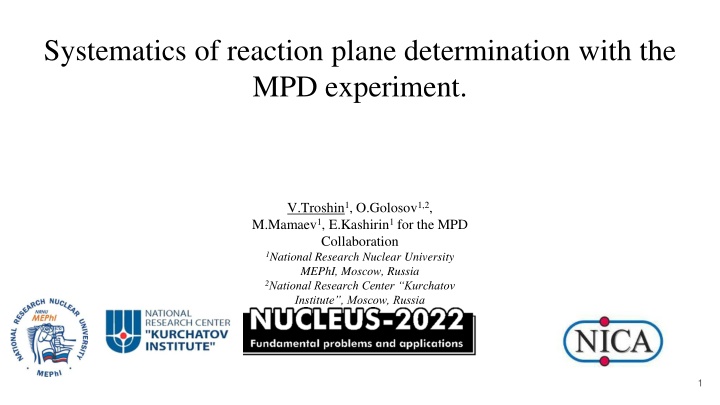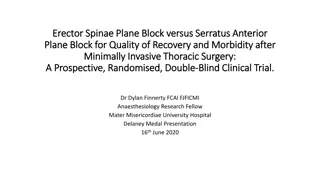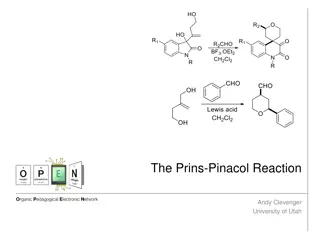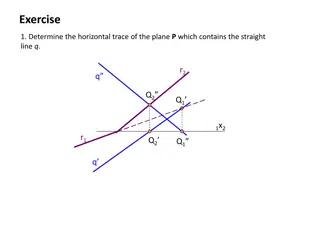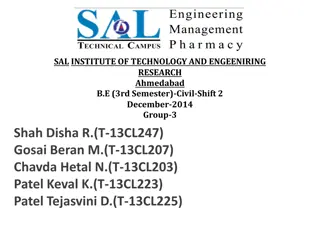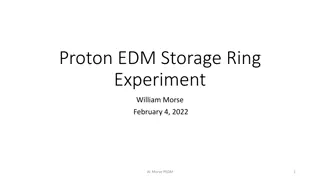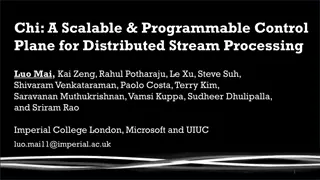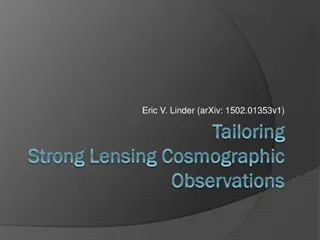Systematics of Reaction Plane Determination with MPD Experiment
An investigation into the anisotropic transverse flow in heavy-ion collisions at Nuclotron-NICA energies, focusing on the MPD experiment's capabilities in studying momentum anisotropy and collective expansion effects through sophisticated tracking and particle identification systems. The experiment aims to decipher the properties of strongly-interacted matter in the energy region using advanced measurement techniques and simulations within the MpdRoot environment.
Download Presentation

Please find below an Image/Link to download the presentation.
The content on the website is provided AS IS for your information and personal use only. It may not be sold, licensed, or shared on other websites without obtaining consent from the author.If you encounter any issues during the download, it is possible that the publisher has removed the file from their server.
You are allowed to download the files provided on this website for personal or commercial use, subject to the condition that they are used lawfully. All files are the property of their respective owners.
The content on the website is provided AS IS for your information and personal use only. It may not be sold, licensed, or shared on other websites without obtaining consent from the author.
E N D
Presentation Transcript
Systematics of reaction plane determination with the MPD experiment. V.Troshin1, O.Golosov1,2, M.Mamaev1, E.Kashirin1for the MPD Collaboration 1National Research Nuclear University MEPhI, Moscow, Russia 2National Research Center Kurchatov Institute , Moscow, Russia 1
Anisotropic transverse flow Spatial asymmetry of energy distribution at the initial state is transformed, through the strong interaction, into momentum anisotropy of the produced particles. In the experiment reaction plane angle RPcan be approximated by participant PP or spectator SPsymmetry planes. 2
Anisotropic transverse flow in heavy-ion collisions at Nuclotron-NICA energies Strong energy dependence of dv1/dy and v2at SNN =4-11 GeV. Anisotropic flow at FAIR/NICA energies is a delicate balance between: The ability of pressure developed early in the reaction zone and Long passage time (strong shadowing by spectators). BM@N CBM MPD Differential flow measurements vn( SNN , centrality, pid, pT, y) will help to study: effects of collective (radial) expansion on anisotropic flow interaction between collision spectators and produced matter baryon number transport Several experiments (MPD, BM@N, STAR FXT, CBM, HADES, NA61/SHINE) aim to study properties of the strongly-interacted matter in this energy region. M. Abdallah et al. [STAR Collaboration] 2108.00908 [nucl-ex]
MPD experiment 4 spectrometer designed to work at high luminosity in the energy range of the NICA collider (4-11 GeV) apable of detecting of charged hadrons, electrons and photons. Precise 3-D tracking system and a high-performance particle identification system based on the time-of-flight measurements and calorimetry. Two hadron calorimeters (FHCal) allow for reconstruction of projectile and target spectator symmetry planes. FHCal (transverse plane) 4
Dataset DCM-QGSM-SMM model (realistic yields of spectator fragments for symmetry plane reconstruction) Bi-Bi @ 9.2 GeV, 4M events Geant4 transport (important for proper simulation of hadronic showers) Simulation and reconstruction within MpdRoot environment Analysis description Centrality based on multiplicity of reconstructed tracks Event selection Successfully reconstructed primary vertex position Track selection |DCA|<0.5 number of hits in TPC >16 track matched to TOF hit Particle identification PDG of matched Monte Carlo track 5
Scalar product method for vnmeasurement u and Q-vectors: Here wkis energy in k-th module of FHCal. Scalar product method gives independent estimates for flow values obtained with different Q-vector components and symmetry plane sources. v1with respect to symmetry plane Sis calculated using group of particles (modules) a : Ra1,iis a 1storder event plane resolution correction (details in the following slides) 6
Corrections for azimuthal acceptance non-uniformity recentering Non-uniformity of azimuthal acceptance may introduce substantial bias on the flow measurement results. Data-driven differential (centrality, primary vertex position, particle type or kinematics, etc.) corrections were applied for u and Q-vectors: recentering twist rescaling. Implemented in QnTools framework (along with multidifferential Q-vector correlations and tools for correlation arithmetics and error propagation). https://github.com/HeavyIonAnalysis/QnTools twist rescaling 7
Reconstructed resolution correction (2-subevent method) N - northern FHCal S - southern FHCal Good agreement with true resolution for the full FHCal and separate module rings except for most central events (minimal anisotropy of nuclei overlap area). Consistent results for X and Y components - only combined values on further slides. 8
Effect of acceptance corrections on full FHCal resolution No effect in case of fully functional detector Rescaling minimizes the effect of failing modules (marked red) on the symmetry plane estimate 9
Effect of acceptance corrections on FHCal rings resolution Rescaling minimizes the effect of failing modules (marked red) on the symmetry plane estimates from module rings 10
Proton directed flow relative to spectator symmetry plane v1 dependences calculated relative to spectator symmetry plane are in good agreement with those from the event generator. 11
Summary Good agreement of reconstructed and true resolution for the full FHCal and separate module rings except for most central events with 2 subevent method. Consistent resolution values obtained with X and Y components of Q-vectors. Corrections for non-uniform acceptance can minimize the effect of failing FHCal modules. pT and rapidity dependences of directed flow calculated relative to spectator symmetry plane are in good agreement with values from the event generator. Outlook: Systematics of flow measurements relative to different spectator symmetry plane estimates (FHCal module groups) and participant plane 12
